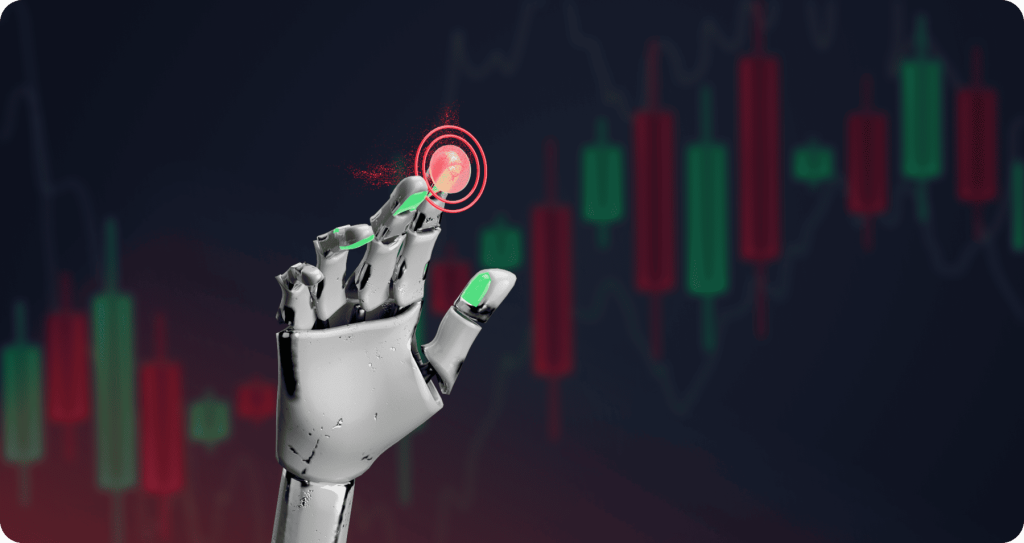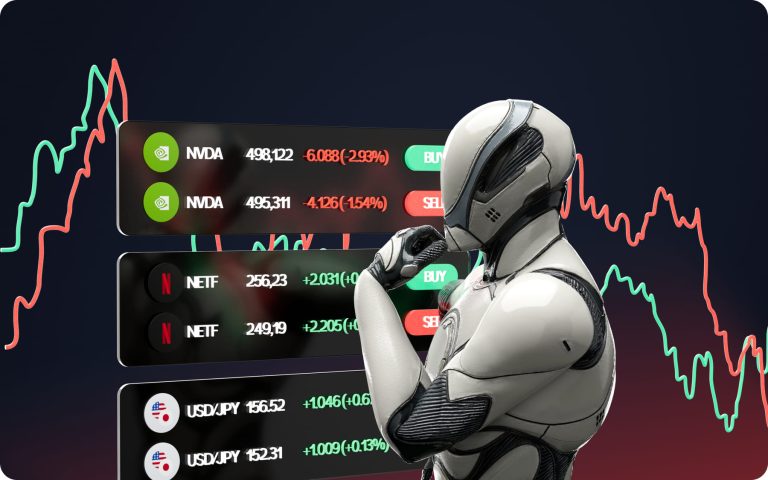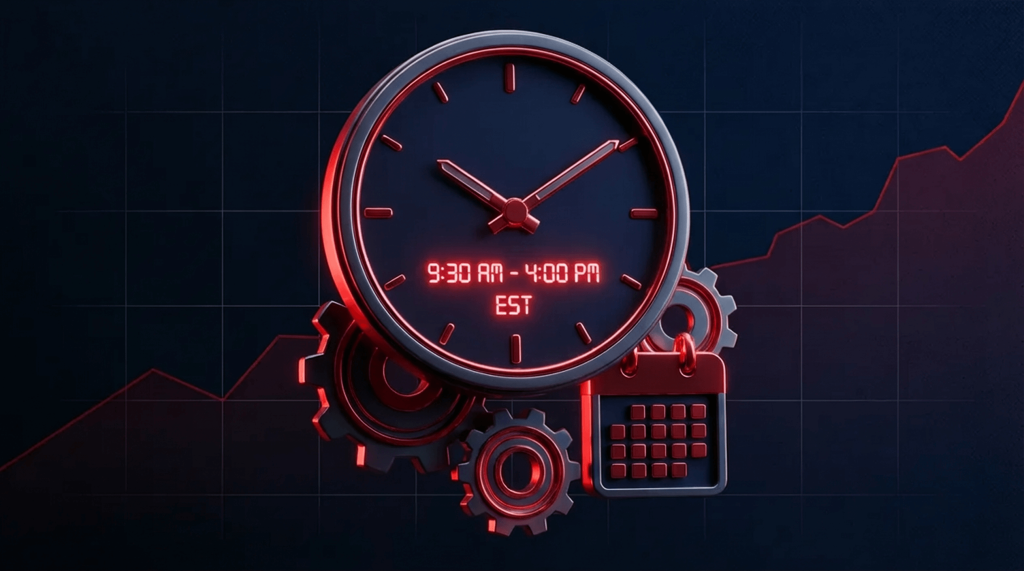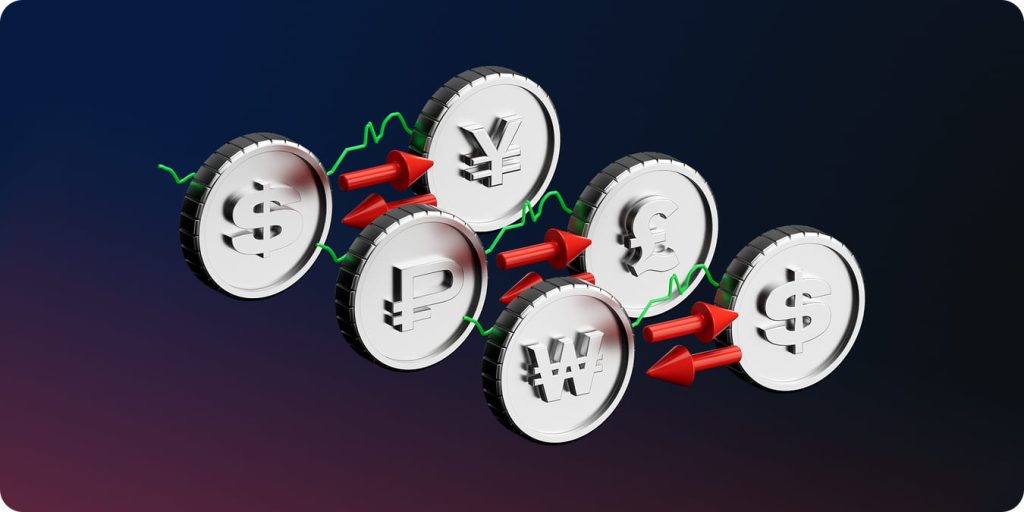
How to Use AI in Trading: a Beginner’s Guide
Contents
Artificial Intelligence has revolutionized the trading sector unlocking a number of brand new opportunities for both newcomers and professional traders. Meanwhile, beginners need to understand that AI-powered tools are not a solution that brings money and requires no skills. How to use AI in trading properly and avoid common mistakes?
Key takeaways:
- AI is a force multiplier, not a money printer. AI makes research and execution faster, but profit still comes from a good strategy, risk control, and discipline.
- Simplicity is key, safe testing. Test one rule-based concept on a demo account 2-4 weeks, then live with small size only after seeing consistent results.
- Risk first. Cap risk at ~0.5-2% per trade, establish SL/TP prior to entry, and aim for a risk-reward of at least 1:2 to preserve capital.
- Use bots that you understand. Avoid “guaranteed return” utilities. Prefer systems with simple logic, parameterizable parameters, backtests, and audit logs.
- Choose the correct environment. Trade on a platform that supports bots, paper trading, and good monitoring so you can halt, re-tweak, or roll back safely.
- Adjust and monitor. Track hit rate, avg win/loss, drawdown, and slippage; retrain or turn off when market regime changes (“black swans” do happen too).
- Keep learning. AI boosts your edge, but ongoing skill-building in markets, data, and risk management keeps performance sailing.
Practical Steps to Start Trading with AI
Take the following steps into account to earn profits and steadily improve your trading results.
- Learn the basics. Start with the basics. Learn how the market works and what AI can do for trading. Study the core terms, basic strategies, and other important notions.
- Choose the right trading platform. Open an account on a trading platform that is compatible with the vast majority of trading robots so that you could connect all the bots and advisors you want.
- Start with free AI-powered trading bots. Try to understand the working principles of such a robot, set some necessary settings, and so on. Test your robot on a demo account to evaluate its efficiency.
- Get more professional robots. Look through the reviews and get a trading bot that is effective enough for beginner traders.
- Set the required settings, goals, and risk management limits. You need to adjust your trading robot to your trading strategy, goals, risk management principles, etc. Define your targets and possible risks. Beginner traders are recommended to start with less risky strategies.
- Monitor your trading results. Track the performance of your trading robot on a constant basis and change your strategies or settings if something goes wrong.
- Upgrade your skills. No matter how effective your AI-driven robots are, never stop upgrading your skills and professionalism. Furthermore, keep up with the time looking for other AI trading tools.

The Most Common Practices Traders Use AI
It is one thing to know what AI can do, but what exactly are traders using it for on a daily basis? Here are the most common practices where traders use AI:
1. Market sentiment analysis
AI software scans thousands of news articles, earnings reports, and even tweets in real time. This allows traders to quickly establish whether the sentiment of the market is bullish, bearish, or neutral when making a decision.
2. Chart pattern recognition
Machine learning can identify price patterns, like head-and-shoulders or breakouts, quicker than the naked eye can, alerting traders to potential entry or exit points.
3. Portfolio risk management
AI programs monitor open positions and hedge or rebalance automatically when volatility increases. For example, a bot can close a position on a particular currency pair if it exceeds your defined risk tolerance.
4. Trading automation
Instead of watching charts 24/7, traders can use AI bots that automatically open and close positions based on defined rules. This implements discipline and consistency.
5. Backtesting strategies
Artificial intelligence-driven backtesting enables traders to test strategies on past performance in seconds and see what works and what does not before putting real money on the line.
In other words, AI isn’t simply “data analysis:” it’s becoming a trader’s aide for identifying trends, managing risk, and making trades with accuracy.
AI Trading Applications vs. Advantages
| AI Trading Application | How It Assists Newcomers |
| Market mood analysis (news, social, reports) | Instantly indicates whether the market sentiment is bullish or bearish without manually scanning numerous sources |
| Chart pattern recognition | Identifies breakouts, reversals, or trend continuation faster than manual detection |
| Portfolio risk monitoring | Manages exposure and adjusts automatically to minimize drawdowns |
| Trade automation (bots) | Opens/closes positions 24/7 with no emotional influence |
| Backtesting strategies | Tests strategies on historical data in seconds, avoiding costly trial and error |
What is the Role of Artificial Intelligence in Trading?
The term “AI trading” refers to the usage of diverse AI-powered technologies while opening and closing positions. The core goal lies in analyzing giant scopes of information and automating trades.
AI-driven tools are able to process exceptionally large data volumes (e.g., market data, tech indicators, fundamental factors, and so on). Such information is geared together to provide a trader with the understanding of which price movements are the most predictable. With the help of Artificial Intelligence, traders are able to work on both short-term and long-term trading/investment strategies.
Furthermore, AI-driven tools can automate your trades through opening and closing positions according to the chosen strategy.
You may also like

What are the AI-Driven Technologies Used in Trading the Most?
Among the core AI technologies that are used in trading, the following ones are pointed out:
- ML (machine learning) algorithms. Such tools are oriented to the analysis of historical data, detect some trend or reversal patterns, and decide whether an asset’s price is going upwards or downwards.
- NLP (natural language processing) technologies. The core goal of such an instrument is to analyze thousands of news articles to identify the current market sentiments and outline fundamental factors that can influence price shifts.
- Big Data. The tools process enormously giant scopes of market data to determine market trends and possible reversals.
As such, AI-driven technologies save a trader’s time. The instruments analyze tons of information, news articles, and market data within seconds when an average trader would spend weeks or even months to do the same.
What are the Main Benefits of Artificial Intelligence for Beginner Traders?
When talking about newcomer traders in particular, the following core benefits of AI trading are outlined:
AI-powered tools save a trader’s time and provide access to giant scopes of data.
Professional traders are able to eject the necessary information quickly while beginners spend much time looking for news articles, activating tech analysis instruments, and so on. AI tools make everything much more quickly and more effective.
Artificial Intelligence is an effective solution towards emotionless trading.
Emotions and spontaneous decisions that are out of the chosen strategy lead to heavy losses. When a beginner trader opens positions just on his own, emotions may run high and ruin everything. AI-powered algorithms are not influenced by emotions and open positions according to the selected strategy only no matter how beneficial different options seem to be.
AI-driven instruments are 24/7 in service.
Trading can be rather exhausting, especially for beginners. When a newcomer trader spends too much time in front of his monitors, that is much easier to make mistakes. Artificial Intelligence is always precise and never gets tired.
AI-powered tools enable traders to work on different markets and timeframes simultaneously.
Artificial Intelligence provides traders with quick and precise decisions based upon the profound analysis of financial markets; here is why beginner traders are able to open positions with different assets on various timeframes.
The Limitations and Risks of AI Trading for Beginner Traders
When talking about benefits only, Artificial Intelligence seems to become the best solution for newcomer traders; meanwhile, such tools are characterized by a number of limitations and risks. Which ones are the most significant ones?
- The efficiency of AI-driven tools depends much on the underlying software quality. Trading tools are designed, built, and trained manually, and beginner traders can hardly distinguish effective instruments from faulty ones.
- Many AI-powered tools are provided by fraudsters. When talking about different robots and advisors, the Internet is full of suggestions that promise exceptionally high incomes. Meanwhile, the reality says that the most effective robots are used by their creators only.
- Trading robots do not take market changes into account. AI-driven instruments are based on historical data no matter how quickly that data is updated. Financial markets can be influenced by sudden changes that are called “black swans.”
- Artificial Intelligence tells beginner traders they do not need to upgrade their skills. And that is one of the most common mistakes. It is exceptionally important for beginner traders to upgrade their skills constantly, as AI-driven tools cannot bring you success without your professionalism.
Pros and Cons of Using AI in Trading
| Advantages of AI | Constraints and Risks |
| Handles massive amounts of data in seconds | Efficiency is highly dependent on algorithm quality and developer reliability |
| Emotionless decision-making (no greed or no fear)Runs 24/7 without tiring | High risk of encountering fake bots that will promise “guaranteed returns”Can’t predict unexpected “black swan” events |
| Can trade more than one asset and timeframes at once | Traders will over-rely on bots and stop developing their own skills |
Which Trading Platforms Are Compatible with AI-Powered Robots and Advisors?
When you are going to make your first steps into trading, think over the platforms that enable their clients to use AI-driven bots. Here are some of the most popular platforms:
- IQ Option
- Metatrader (4 and 5);
- AlgoTrader;
- RoboForex;
- Trade Ideas;
- Kavout.
When talking about other trading platforms, one is able to contact customer support and find out whether AI-powered instruments are supported or not.
How to Choose the Right AI-Powered Trading Bot for Beginners?
What are the most important criteria that help beginner traders select the right AI-driven trading robot?
- Supported asset classes. Such a criterion is of much account as a trader needs to understand whether a bot is compatible with asset classes you are going to use in trading. For instance, a trader is going to trade digital currencies – that is clear that it’s not a good decision to get a robot that trades Forex currencies only.
- Compatibility with trading platforms. One more important criterion lies in the fact that the chosen bot should be compatible with a trading platform you prefer to open positions on.
- Required input. Find out how much input a trading bot needs to show efficiency. On the other hand, you are able to get ready-made robots; meanwhile, we are back to the question if a developer is ready to share successful strategies with everyone.
The above-mentioned criteria are the core ones when a trader is looking for the best AI-based solution for opening positions on different financial markets.
How to Use AI in Trading Properly: a Step-by-Step Guide for Beginners
When you are going to get profits and improve your trading results steadily, take the following steps into account:
- Learn the basics. Start with the basics. Learn how the market works and what AI can do for trading. Study the core terms, basic strategies, and other important notions.
- Choose the right trading platform. Open an account on a trading platform that is compatible with the vast majority of trading robots so that you could connect all the bots and advisors you want.
- Start with free AI-powered trading bots. Try to understand the working principles of such a robot, set some necessary settings, and so on. Test your robot on a demo account to evaluate its efficiency.
- Get more professional robots. Look through the reviews and get a trading bot that is effective enough for beginner traders.
- Set the required settings, goals, and risk management limits. You need to adjust your trading robot to your trading strategy, goals, risk management principles, etc. Define your targets and possible risks. Beginner traders are recommended to start with less risky strategies.
- Monitor your trading results. Track the performance of your trading robot on a constant basis and change your strategies or settings if something goes wrong.
- Upgrade your skills. No matter how effective your AI-driven robots are, never stop upgrading your skills and professionalism. Furthermore, keep up with the time looking for other AI trading tools.
You may also like

The Common Mistakes of Beginner Traders Who Enter the AI Trading Market
What are the most widespread mistakes of beginner traders who deal with AI-powered trading instruments?
- Rely on trading bots entirely. AI-driven tools are a perfect helping hand for a trader but never think that a robot will earn money instead of you. That doesn’t work this way.
- Purchase robots that are 100% precise. No trading bot can be 100% effective because the financial markets are rather unpredictable despite technical and fundamental analysis.
- Stop keeping up with the times and learning something new. The more professional and skilled a trader you are, the more effective and profitable AI-driven solutions are going to become.
The Bottom Line: Should a Beginner Trader Use AI-Driven Trading Tools?
Trading with the help of Artificial Intelligence is much more efficient than manual trading; meanwhile, traders need to become professional enough to use AI-driven tools properly. On the other hand, AI tools will help beginners improve their skills, process large amounts of information and determine the most effective trading strategy, and then adjust it if necessary. As such, Artificial Intelligence is a must-have for both beginners and professional traders.
FAQ
In fact, the vast majority of expensive trading robots bring profits for short periods of time only. No developer is ready to sell “the goose that lays him golden eggs.
Yes, speed and the ability to process large amounts of information mean a lot in modern trading. Without the use of AI tools, a trader simply risks being uncompetitive.
They should select instruments that are clear enough for them and let traders improve their skills. One needs to monitor trading results constantly and make adjustments to his strategy if necessary.
Updated:
September 4, 2025
8 January, 2026
Stock Market Hours: When Does The Market Open?
Most major stock markets are open Monday to Friday, with opening times depending on the exchange and its time zone. For example, US stock markets open at 9:30 AM ET, while the London Stock Exchange opens at 8:00 AM UK time. There is no regular stock trading on weekends. Below, you’ll find a clear, practical […]




